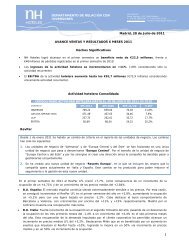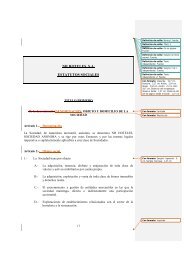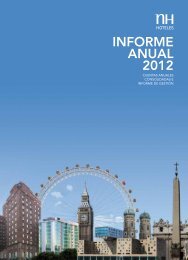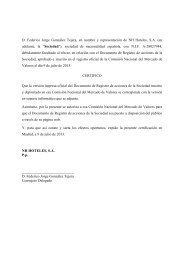Download Complete PDF - Informe Anual 2012
Download Complete PDF - Informe Anual 2012
Download Complete PDF - Informe Anual 2012
Create successful ePaper yourself
Turn your PDF publications into a flip-book with our unique Google optimized e-Paper software.
Authorisation of the Board shall not be required however, for related party transactions that simultaneously meet the following three conditions:<br />
1ª. That are carried out under agreements with standardised conditions and are applied in a general way to numerous clients;<br />
2ª. That are carried out at established rates or prices, which in general are set by the supplier of the good or service;<br />
3ª. Operations with a quantity that does not exceed 1% of the company’s annual revenues.<br />
The Board is advised to approve related party transaction that receive a prior favourable report from the Audit Committee or from any other<br />
committee that has been authorised to this end; and that the directors involved not only abstain from voting (without the right to delegation),<br />
but also vacate the meeting room while the Board deliberates and votes on the issue.<br />
It is advisable that the competencies attributed to the Board in these matters should not be delegated, except in the aforementioned points b)<br />
and c), which may be adopted for reasons of urgency by the Executive Committee, and subsequently ratified by a plenary session of the Board.<br />
See sections: C.1 and C.6<br />
Partially complies<br />
The Company complies with the recommendation in this section, except for those points established in section b.i.), for which the Board of Directors<br />
considers that the decision regarding the appointment and possible removal of senior managers must correspond and continue to correspond to<br />
the Chief Executive Director of the Company. Notwithstanding the above, the Regulations of the Board of Directors attributes responsibility to the<br />
Appointments and Remuneration Committee to provide a prior report on the appointment or dismissal of the managers that report directly to the<br />
Chief Executive Director.<br />
9. That, in the interests of effectiveness and participation, the Board should comprise no less than five and no more than 15 members.<br />
See section: B.1.1<br />
Complies<br />
10. External proprietary directors and independent directors comprise a significant majority of the Board of Directors, and the number of executive<br />
directors is kept to a minimum, taking into account the complexity of the corporate group and the percentage shareholdings of the executive<br />
directors in the company.<br />
See sections: A.2, A.3, B.1.3 and B.1.14<br />
Not applicable<br />
11. If there is an external director who cannot be considered a proprietary director or an independent director, the company should explain this<br />
circumstance and their relationship either with the company or its managers, or its shareholders.<br />
See section: B.1.3<br />
Not applicable<br />
12. Among the external directors, the proprietary/independent director ratio should reflect the existing ratio between the capital of the company<br />
represented by the proprietary directors and the remaining capital.<br />
This criterion of strict proportionality can be relaxed so that the percentage of proprietary directors is greater than the total percentage of capital they represent:<br />
1º In large cap companies in which few or no shareholdings are legally considered significant, but which include block stockholdings of<br />
considerable value.<br />
2º In companies in which there are numerous shareholders represented on the Board and these shareholders have no links between them.<br />
See sections: B.1.3, A.2 and A.3<br />
Complies<br />
13. The number of independent directors represents at least one third of the total directors.<br />
See section: B.1.3<br />
Explain<br />
Of the 15 directors that make up the Board of Directors of NH Hoteles, S.A., ten are external directors, four are independent directors and one is an executive<br />
director. The four independent directors represent 26.667% of the total number of members, which, rounded up, makes up a third of the members.<br />
14. Each specific directorship is explained by the Board to the General Shareholders’ Meeting, which must make or ratify the appointment, and is<br />
confirmed or, as applicable, reviewed annually in the Annual Corporate Governance Report following verification by the Appointments Committee;<br />
and this report also explains the reasons why proprietary directors may have been appointed at the request of shareholders who hold less than 5%<br />
of the capital; and states the reasons for denying, as applicable, formal requests for representation on the Board from shareholders whose holding is<br />
equal to or above that of other shareholders at whose request proprietary directors have been appointed.<br />
See sections: B.1.3 and B.1 4<br />
Complies<br />
15. When the number of directors is few or none, the Board explains the reasons and the initiatives adopted to correct this situation; and in particular,<br />
the Appointments Committee ensure that when new vacancies arise:<br />
a) The selection procedures do not suffer from any implicit bias that hampers the selection of female directors;<br />
b) The company deliberately seeks and includes women who match the professional profile sought among the potential candidates.<br />
50 ANNUAL CORPORATE GOVERNANCE REPORT
















